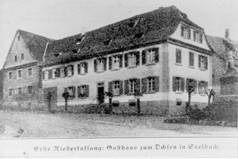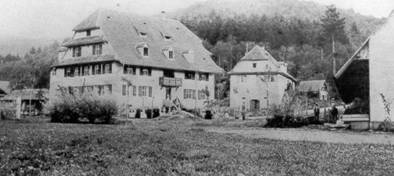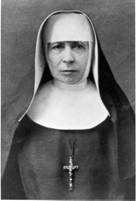German Foundation
| 1866 Franciscan Sisters Foundation Germany |
The early history of this community of Franciscan Sisters centered around the village of Seelbach, in the then Grand Duchy of Baden, Germany. Here, in the shadow of the famous Black Forest, the Reverend Wilhelm Berger, pastor of the parish church, realizing the difficulty that his parishioners experience in procuring proper nursing care in the time of illness, determined to organize a society of young women who would undertake the care of the sick, the aged and the children and simultaneously carry into their spheres of activity the two-fold purpose of the Incarnation – the honor of God and the salvation of their own souls and the souls of others who might be entrusted to them. Under the inspiration and guidance of this intrepid shepherd of souls, twelve pious and alert young ladies – six from his own parish and six from the adjoining parishes – finally formed, in the year 1866, the nucleus of a religious community conforming from its earliest existence to the Rule of the Third Order Regular of St. Francis.
|
| 1866 First Home in Germany |
|
| Ochsen in Seelbach |
And all the time, every effort was being made to lay the solid foundation for future activities – spiritual and temporal. Lectures and conference on religious subjects were regularly given. The Office of Our Lady was recited in the German language daily and in common. The members attended the Holy Sacrifice of the Mass and other services in the parish church. Instructions in the care of the sick were of paramount importance and, in such subjects classes were conducted by capable and efficient persons. Many of the young Sisters were sent to institutions of higher learning to finish their education. A number of them were placed in the Academy of Siessen under the Franciscan Sisters, others under the Sisters of Charity at Freiburg, and some completed their studies at the Sisters of Notre Dame in Offenburg.
|
| 1868 Trettenhof |
The negotiation for a permanent home began and the Sisters purchased this site on September 4, 1867 for the sum of $29,000.00 and the community moved into its first Motherhouse. A separate two-story building near the large hall was used for lecture purposes. The chapel was dedicated on October 15, 1868. A resident chaplain was appointed and the Sisters had the happiness of having Holy Mass in their own chapel every day, as well as the consoling Presence of Our Divine Lord in the tabernacle. After erecting a chapel in this place, they called it “Maria Hilf.”
|
|
|
| Sister M. Anastasia Bischler |
Born January 19, 1834, in Wingerbach, Baden, Germany, Sister M. Anastasia Bischler, at the age of thirty-two cast her lot with the little group of pioneers in Seelbach and decided to dedicate her life to God in the service of humanity. She was a pious, industrious young lady, possessing a high degree of intelligence, tact, courage, sound judgment and foresight. She had, in a short time, devotedly served in various capacities in the community, being the seamstress for a short tune in the community. She it was who made the first habit for many of the new members. She was never idle and apparently never tired. Imbued with the spirit of faith she gave herself generously and devotedly to the problems of her community. When her appointment as the first Mistress of Novices came, she was busily engaged in cutting out a new habit for one of the Sisters. This she left at once and responded to the call of obedience.
|
| 1866 -- 1876 Rev. Wilhelm Berger |
During this period of time, 1866 – 1876, the number of Sisters in the community reached sixty and the number of houses was eleven. Then came distress. In consequence of the trouble in Germany between Church and State, the Sisters had to abandon community life and with it their homes, which they had acquired by untold sacrifices. Although credit was due them from their country for having taken part in nursing, etc., during the War of 1870, this was their fate. Twenty-seven of these persecuted Sisters came to the United States of America. They traveled in various groups and at different times. These Sisters deserve credit for establishing our present community in the year 1876.
|
| 1876 Sisters leave Germany |
In 1876, just a decade after its inception, the community of the new Order, the Franciscan Sisters of Seelbach was faced with the problem of finding a new home on foreign soil; the hostile government of Bismarck had no place for them in the Empire. Belgium, and strange to relate, the Holy Land, were countries considered as havens of refuge and possibl7 fields of future missionary activities, but after a chance meeting with the Reverend Dominic Duehmig of Avilla, Indiana, who was at that time on a visit to his native land, the Sisters decided to come to America, the land of opportunity, where religious foundations were sadly needed as Father Duehmig had truthfully informed them. The story recorded in the German Chronicles states that when the Sisters arrived in New York they stayed with the Franciscan Sisters of the Poor in a Hospital in New York.
|




 Lenzlishof, Seelbach near Lahr The first place of community life was in a farm house in Seelbach on a place known as Lenzlishof, the property of Mrs. Mathilda Himmelsbach, a widow whose daughter, Magdalen (Sister M. Coletta), had for a long time entertained the thought of entering a convent.
Two girls from Oensbach, later known in religion as Sister M. Angela Seiler and Sister M. Elizabeth Weber, joined her. They occupied a small upstairs room in the farmhouse and lived in seclusion and poverty. They willingly nursed the sick of the parish and those in the vicinity.
Lenzlishof, Seelbach near Lahr The first place of community life was in a farm house in Seelbach on a place known as Lenzlishof, the property of Mrs. Mathilda Himmelsbach, a widow whose daughter, Magdalen (Sister M. Coletta), had for a long time entertained the thought of entering a convent.
Two girls from Oensbach, later known in religion as Sister M. Angela Seiler and Sister M. Elizabeth Weber, joined her. They occupied a small upstairs room in the farmhouse and lived in seclusion and poverty. They willingly nursed the sick of the parish and those in the vicinity. Soon their number increased as more members of the Third Order joined them. In order to have a larger home, they rented an inn called Ochsen in Seelbach.
Soon their number increased as more members of the Third Order joined them. In order to have a larger home, they rented an inn called Ochsen in Seelbach. With the steady growth of the community this home also became too small. For a third one, they chose a place known as Trettenhof near Seelbach.
With the steady growth of the community this home also became too small. For a third one, they chose a place known as Trettenhof near Seelbach.  With adequate accommodations available at the new “Motherhouse”, the number of applicants increased very rapidly and the little community counted sixty Sisters and novices in its ranks actively engaged in the works of charity at the close of the first ten years. “Trettenhof”, under the patronage of Our Blessed Mother, “Maria Hilf”, had become the headquarters. From here they continued to go out into the homes of the sick and care for suffering humanity. Many sick and wounded victims of the Franco-German War were tenderly nursed back to health and happiness by the loyal members of this devoted company.
With adequate accommodations available at the new “Motherhouse”, the number of applicants increased very rapidly and the little community counted sixty Sisters and novices in its ranks actively engaged in the works of charity at the close of the first ten years. “Trettenhof”, under the patronage of Our Blessed Mother, “Maria Hilf”, had become the headquarters. From here they continued to go out into the homes of the sick and care for suffering humanity. Many sick and wounded victims of the Franco-German War were tenderly nursed back to health and happiness by the loyal members of this devoted company. In eighteen Field and Base Hospitals, the Sisters were engaged during and after the war. Many cases of typhoid and smallpox had developed and were cared for by those Sisters. The “Iron Cross”, a great mark of distinction was bestowed by the German Government upon Sister M. Frances for “faithful service on the battlefield” at that time.
In eighteen Field and Base Hospitals, the Sisters were engaged during and after the war. Many cases of typhoid and smallpox had developed and were cared for by those Sisters. The “Iron Cross”, a great mark of distinction was bestowed by the German Government upon Sister M. Frances for “faithful service on the battlefield” at that time.
 Reverend Dominic Duehmig
Reverend Dominic Duehmig